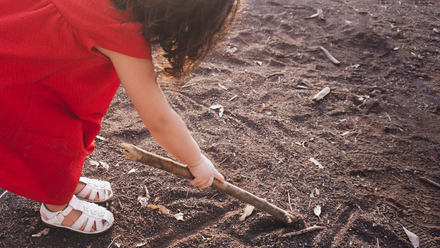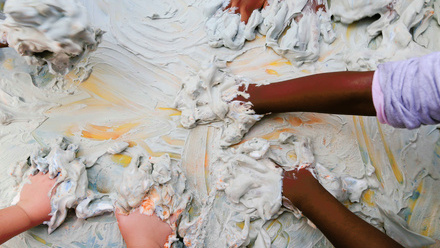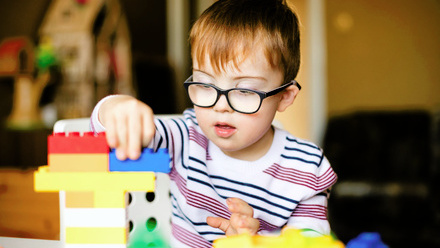Embracing risky play
In his 2007 book, No Fear: Growing up in a risk averse society, Tim Gill explores the ways in which modern society has come to understand everyday challenge and risk for children, and the anxieties this often produces. Nearly 20 years later, the debate into risky play continues – so where does risky play live within our early childhood experiences? Where does our understanding of physical challenge and the act of taking risks develop?
This learning workout aims to look at some of the ways we can come to understand risky play, drawing upon some key examples of risk at play, and learn about safe ways to implement it in practice.
What is risky play?
Risky play is a broad term referring to activities that carry with them an additional element of risk, usually a risk relating to physical injury. It is often attributed to activities taking place outdoors, such as jumping and climbing, but it can apply equally to activities that involve other resources, such as using scissors or garden implements.
What we consider to be risky depends on the context in which it is being used. In some cultures, such as societies in Norway, attitudes towards play in early education and care are generally less risk-averse than our UK understanding which contributes towards a shift in the definition of what is considered ‘high-risk.’ Equally, within the UK, our understanding might also be influenced by community background, such as of local issues concerning children, or by the age and developmental stage of those children we work with.
As with any form of play, engagement in risky play brings its own unique skills that contribute towards a child’s well-rounded development. Because risky play is often found in the outdoor environment, one prominent area of development within this type of play is that of gross motor skills and building strength, balance and coordination. Participation in riskier activities, such as in playing with climbing frames or using balancing beams, provide a novel way to put those physical skills into action!
Risky play also has a range of advantages for children’s social and emotional development. Chances to independently overcome challenges instils confidence in ability, giving children a practical opportunity to manage the risks associated and make informed decisions about their (literal) next steps to reach their immediate goals.
Early education and care settings are all different and will have different spaces that create opportunities for risky play. The building’s structure, its location and learning approach will all contribute to the ways in which risky play is used with children through their early years.
Engaging in riskier play...safely!
Rough and tumble play
Rough and tumble play is defined as “verbal and physical cooperative play behaviour involving at least two children, where all participants enjoyably and voluntarily engage in reciprocal role-playing that includes aggressive make-believe themes, actions, and words; yet lacks intent to harm either [child] emotionally or physically” (Hart and Tannock, 2018).
-
Create safe spaces for accommodating rough and tumble play, such as soft furnishings and establish clear boundaries for how we play safely with each other, respecting when our friends say ‘stop’ and understanding our own strength.
Speedy play
How many times are children asked to use their walking feet during the day? Or mind where they are going as they toddle around the space at speed?
Experimenting with speed is another aspect of building spatial awareness and coordination skills. Exploring this element of risk also paves the way for valuable opportunities to explore real life application of risk, such as through road safety.
-
Use outdoor spaces to encourage speedy play on foot or using equipment like balance bikes, trikes and scooters. Each resource comes with its own benefits. It’s important to highlight the responsibilities we have for looking out for each other by creating an environment that replicates our own roads, using crossings and simple road signs to encourage observational skills to use speed safely.
Using tools
Inside and out, tools can be used for all sorts of activities, some riskier than others. We can utilise tools to heighten this element of risky play and appreciation for caution when it comes to the responsibility of using equipment.
- Tools such as shovels can be used in outdoor spaces for digging in mud and sand and adding new risks to forms of sensory play. Using tools enhances opportunities for hand-eye coordination whilst also giving an appropriate way to discuss using tools safely.
- During art activities, tools like scissors and staplers can also be used to cultivate trust in using sharp objects and understanding the importance of being careful with handling tools versus toys.
Conclusions
Risky play brings with it a variety of benefits that can enhance a child’s wider understanding of judgment, caution and responsibility to use resources safely. However it is important to ensure the activity’s benefits outweigh the risks and that appropriate measures are taken to ensure everyone’s safety, such as clear communication with the wider team, a strong behaviour management policy for dangerous behaviours and a valid, comprehensive risk assessment.
There’s a time and a place for risky play and it’s essential that everyone, adults and children alike, have a full understanding of when it is appropriate to engage with.
Focus on Forest Schools:
Forest schools take a holistic approach that focus on the learner at the centre of practice. Their approach to risk goes beyond the physical aspects of the environment to appreciate the emotional and social risks that children take daily.
Risky play is one of the six main principles in the criteria for good practice, where every experience follows a risk-benefit process to ensure the opportunity holds greater benefits to the individual child than risks to safety and wellbeing.
Watch this seminar from the Forest School Association to explore what risky play involves within a forest school context and think about the similarities and differences to your current understanding and risky play practice.






